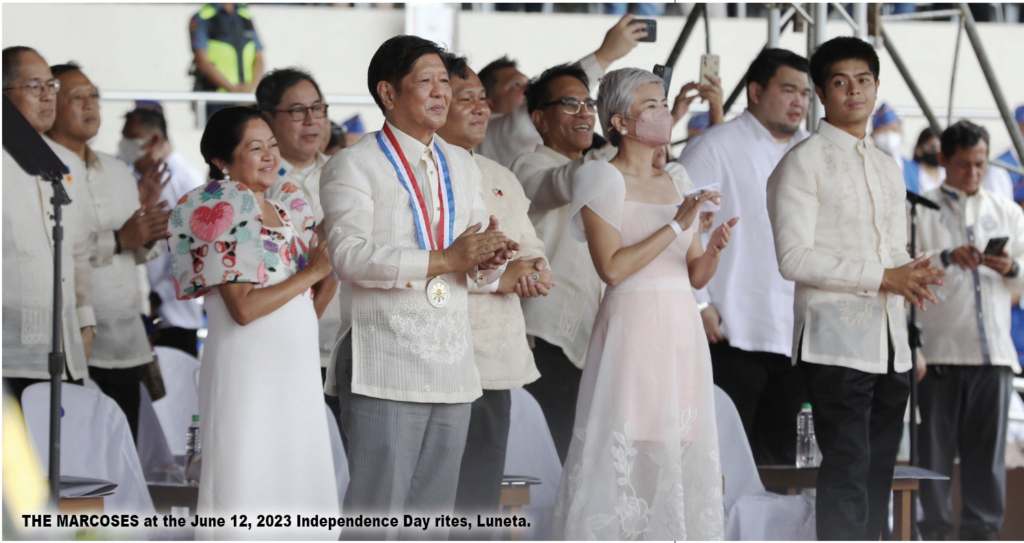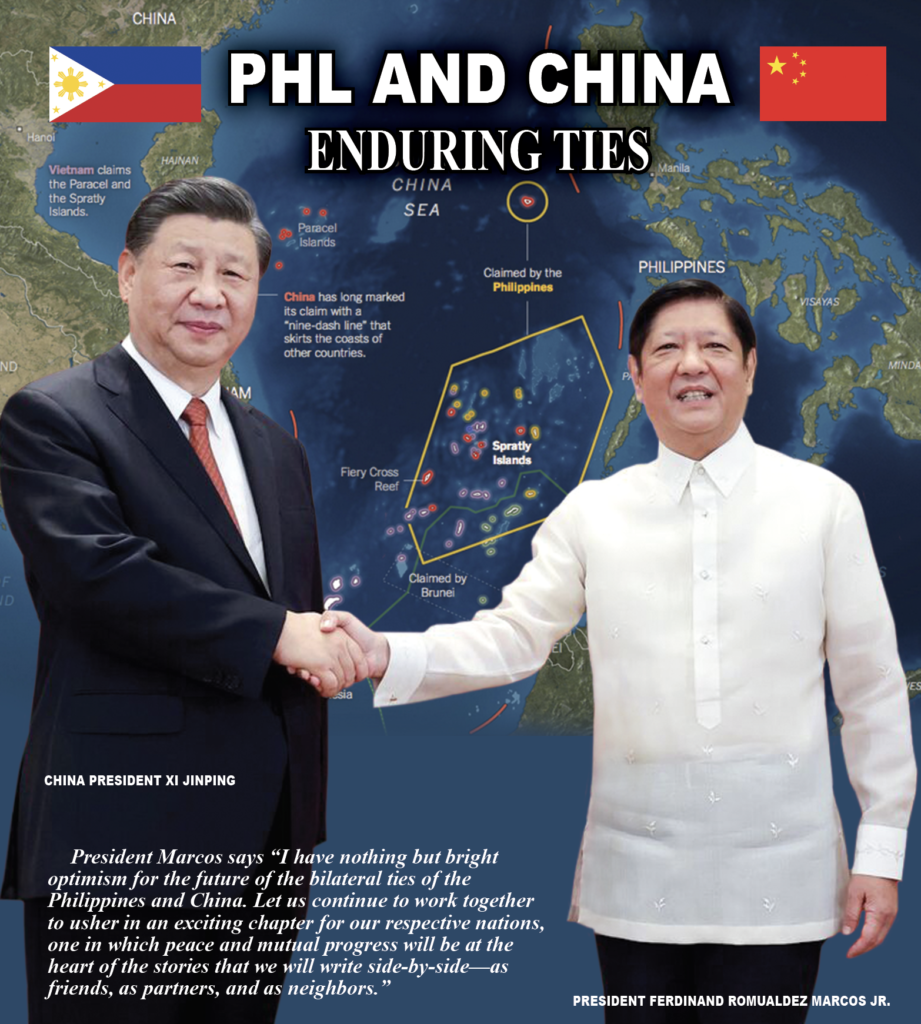By Antonio S. Lopez
On June 9, 2023, the Philippines and China marked the 48th year of formal diplomatic relations.
On June 9, 1975, President Ferdinand Edralin Marcos Sr. and China Premier Chou En-lai signed in Beijing the agreement to establish formal diplomatic relations. Manila began recognizing only one China, the one based in Beijing, and forthwith broke ties with Taiwan, the Nationalist China based in Taipei.
In 1975, China’s was the biggest communist party in the world. It still is.
In 1975, the Philippines was a staunch anti-communist country. At the same time, Marcos Sr. had begun to question the value of American bases, particularly Clark and Subic, on Philippine soil. Eventually, Marcos Sr. shortened the lease on the US bases from 99 to 25 and demanded, and got, rental for the bases, in the billions of dollars.
Today, relations with China are strained.
China occupies 6 reefs
China has occupied at least six reefs in the South China Sea claimed by the Philippines as part of its territory or of its Exclusive Economic Zone – Cuarteron (Calderon Reef), Fiery Cross (Kagitingan), Gaven (Burgos), Hughes (McKennan), Mischief (Panganiban) and Subi (Zamora Reef). It has reclaimed the reefs and built fortifications, missile systems, and air strips making them strategic military bases.

In 2012, China seized the Scarborough Shoal (Bajo de Masinloc or Panatag), a rock that is clearly part of Philippine territory, being just 120 nautical miles from Luzon. It is a rich fishing ground for Filipino fishermen but is now guarded by a constant Chinese Coast Guard presence.
Of the six reefs, the largest in land expansion are: Mischief, 1,379 acres; Subic 976 acres; and Fiery Cross, 677 acres—a total of 3,032 hectares of reclaimed land over which the Philippines has economic rights—the waters and any oil and minerals underneath, the land, and the air above, Makati is only 1,000 hectares. So the Chinese occupied reefs can house three Makati cities.
Manila’s response
In response to Chinese development or depredations in the South China Sea in the reefs and rocks claimed by the Philippines, President Ferdinand Romualdez Marcos Jr. has made a sharp shift towards Washington. He has allowed access by US troops to four additional bases or bases sites in the Philippines, on top of the five previously authorized in 2014 by the BS Aquino III administration.
The sites disclosed last April 2023 are: the Camilo Osias navy base in Sta Ana and Lal-lo airport, both in Cagayan province, and Camp Melchor Dela Cruz in Gamu, Isabela province and the island of Balabac off Palawan.Isabela and Cagayan face north to Taiwan. Palawan is near the disputed Spratly Islands in the South China Sea where China has built artificial islands.
Maritime Issues with China
The Philippines and China have agreed that maritime differences are not the sum total of the relations, says a Department of Foreign Affairs paper.
The Philippines and China, at various levels, have agreed to address all differences at sea through diplomacy and dialogue, and not through the use of force or intimidation, the DFA paper points out.
As stated in the 5 January 2023 PH-CN joint statement of the state visit to China of President Ferdinand Marcos Jr, “the two leaders had an in-depth and candid exchange of views on the situ- ation in the South China Sea, emphasized that maritime issues do not comprise the sum-total of relations between the two countries and agreed to appropriately manage differences through peaceful means. Both sides reaffirmed the importance of maintaining and promoting peace and stability in the region and the freedom of navi- gation in and overflight above the South China Sea, and reached consensus on the peaceful resolution of disputes on the basis of the Declaration on the Code of Conduct of the Parties in the South China, the United Nations Charter, and the 1982 United Nations Convention on the Law of the Sea.”
The Philippines has taken and continues to take diplomatic actions against illegal activities of foreign vessels that have infringed upon Philippine sovereignty, sovereign rights, and jurisdiction in the West Philippine Sea.
BBM visits DC
During President Marcos Jr.’s Washington visit in May this year, President Biden announced that any armed attack on any Philippine armed forces, vessels, aircraft, including those of the Philippine Coast Guard would be considered an armed attack on the US and the latter would respond correspondingly subject to an act or concurrence by the US Congress.
Previously, the West Philippine Sea was not considered part of Philippine territory under the US-Philippine Mutual Defense Treaty of 1951. The Philippines is the US’s only and oldest treaty ally in Asia.
According to a White House paper, “since 1951, the US-Philippines alliance has advanced peace, prosperity, and security for the United States, the Philippines, and the broader Indo-Pacific region.”
Strong and resilient architecture
“Now the United States and the Philippines are modernizing the alliance and building a strong and resilient architecture that is designed to meet emerging challenges, while routinizing joint planning and improving interoperability,” said the paper.
On April 28, the Philippines and the US concluded their largest flagship bilateral military exercise, Balikatan, with 17,000 Filipino and American troops participating.
Manila and Washington are also expanding cooperation among their coast guards “to better address the challenges posed by illegal, unreported, and unregulated fishing and other unlawful maritime activities; when Vice President Harris visited Palawan in November 2022, she announced $7.5 million in new assistance to enhance the capabilities of Philippine maritime law enforcement agencies, as well as a new program to upgrade the Philippine Coast Guard’s vessel traffic management system.”
The four new sites pursuant to the US-Philippines Enhanced Defense Cooperation Agreement (EDCA), the White House paper said, “will strengthen Philippine security and support the Armed Forces of the Philippines’ modernization goals, while driving US investment to local communities across the Philippines and improving our shared ability to rapidly deliver humanitarian assistance and disaster relief.”
Ironclad alliance with the US
Welcoming BBM at the White House last May, President Biden reaffirmed America’s ironclad alliance commitments to the Philippines,
Meanwhile, during his state visit in Beijing last January 2023, President Marcos Jr. underscored the importance of increasing trust and cooperation with China and other nations for economic growth and sustainable development.

In that visit, BBM witnessed the signing of 14 memoranda of agreement. “These will directly result in more funds for our country and more jobs for our people),” he added. Marcos secured US$22.8 billion in investment pledges from Chinese investors.
Aside from these pledges, Marcos and China leader Xi Jinping agreed to establish a “direct communications line” on concerns related to the South China Sea in the West Philippine Sea to prevent any miscommunication between the two countries.
Marcos Jr. vowed that the Philippines would value Philippine-China relations even more than it did nearly five decades ago.
The President said in China: “We will continue to value the relationship between the Philippines and China more than we have done in the past few decades for the interest of our people, for the welfare of our people.”
He reiterated that he considers strengthening ties between the two countries as both a “responsibility” and a “privilege.”
Uninterrupted friendship
According to a paper sent to BizNewsAsia by the Philippine Department of Foreign Affairs, the past 48 years saw a largely uninterrupted friendship and steadily growing political, economic, cultural, and people-to-people engagement.
During the state visit of President Ferdinand R. Marcos Jr. to China in January 2023, he and President Xi Jinping underscored the importance of maintaining the good momentum of the bilateral relations and agreed to further strengthen the Philippines-China relationship of Comprehensive Strategic Cooperation.
Interactions between the peoples of the Philippines and China pre-date the pre-colonial era.
In a paper by Tan (1991), entitled Participation Of The Phil- ippines In The Nanhai Trade: 9th – 16th Centuries, “commerce occurred via the maritime and land silk roads that spread from China through mainland Asia, insular Southeast Asia, and eventually into the Philippines.
The earliest Chinese finds date from the late Tang Dynasty (9th century AD), providing quantitative evidence of the Philippine share in maritime trade. During the Song dynasty, maritime trade increased when the Chinese built vessels that could transport 600 tons of cargo.
At this time, Butuan was a principal trading port in the Philippines.” (Source)
BBM’s China state visit
At the invitation of President Xi Jinping, President Marcos Jr. undertook a state visit to the People’s Republic of China from 03 to 05 January 2023. This marked the President’s first state visit to a country outside of ASEAN, and his first such engagement for 2023.
During the visit, the President had friendly discussions with President Xi, underscoring the positive trajectory of the bilateral relations across various aspects of the Comprehensive Strategic Cooperation the two countries currently enjoy.
The state visit had a strong focus on economic cooperation, with both countries agreeing to work together in addressing the widening trade gap, and cooperating in the areas of agriculture, infrastructure, trade and investment, energy, and people-to-people ties (which includes tourism and education).
Fourteen documents were signed during the state visit, 13 of which are related to economic cooperation, including the renewal of the MOU on the Belt and Road Initiative, Development Cooperation Plan, E-Commerce, and Tourism, among others.
Investment pledges
During the state visit, Chinese investors committed US$22.8 billion in investment pledges.
These investment commitments include US$1.72 billion for agribusiness, US$13.76 billion for renewable energy (RE), and USD 7.32 billion for strategic monitoring (electric vehicle, mineral processing
